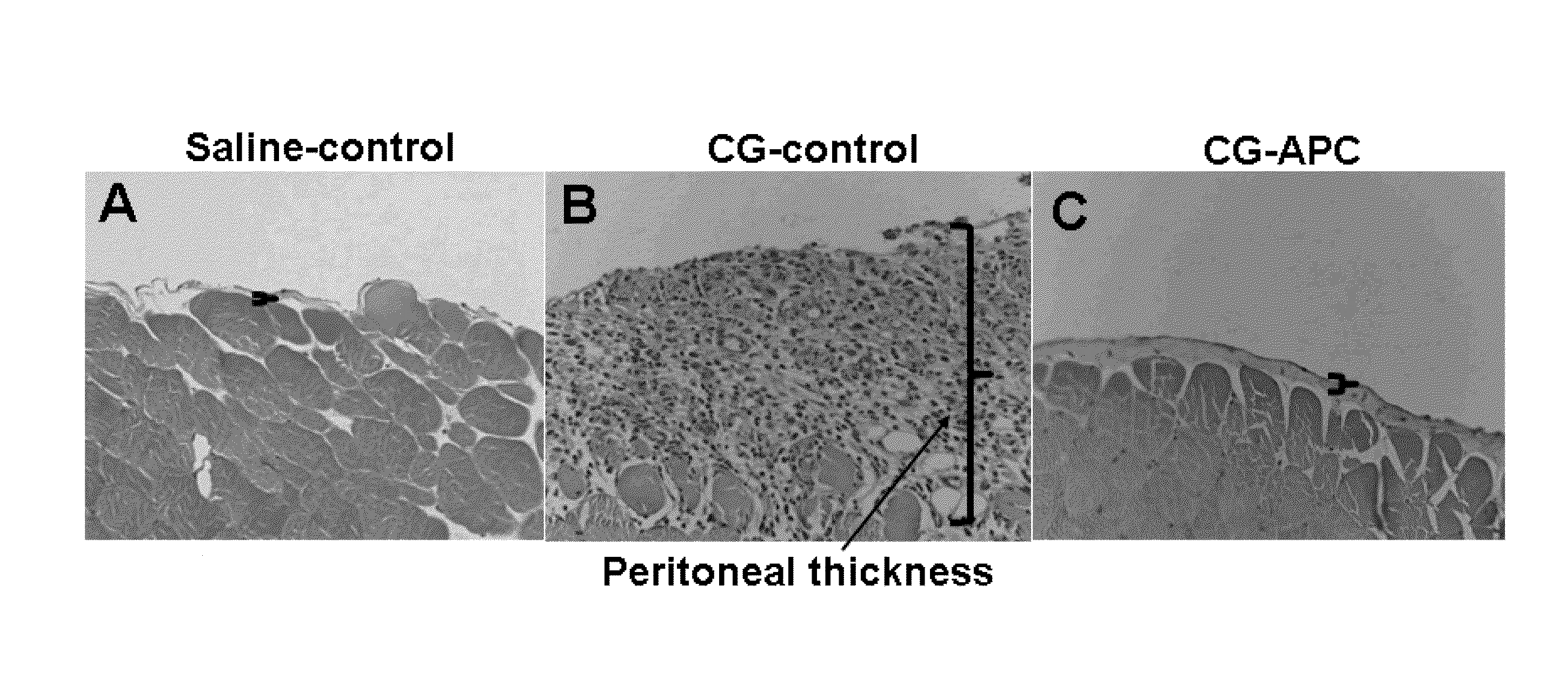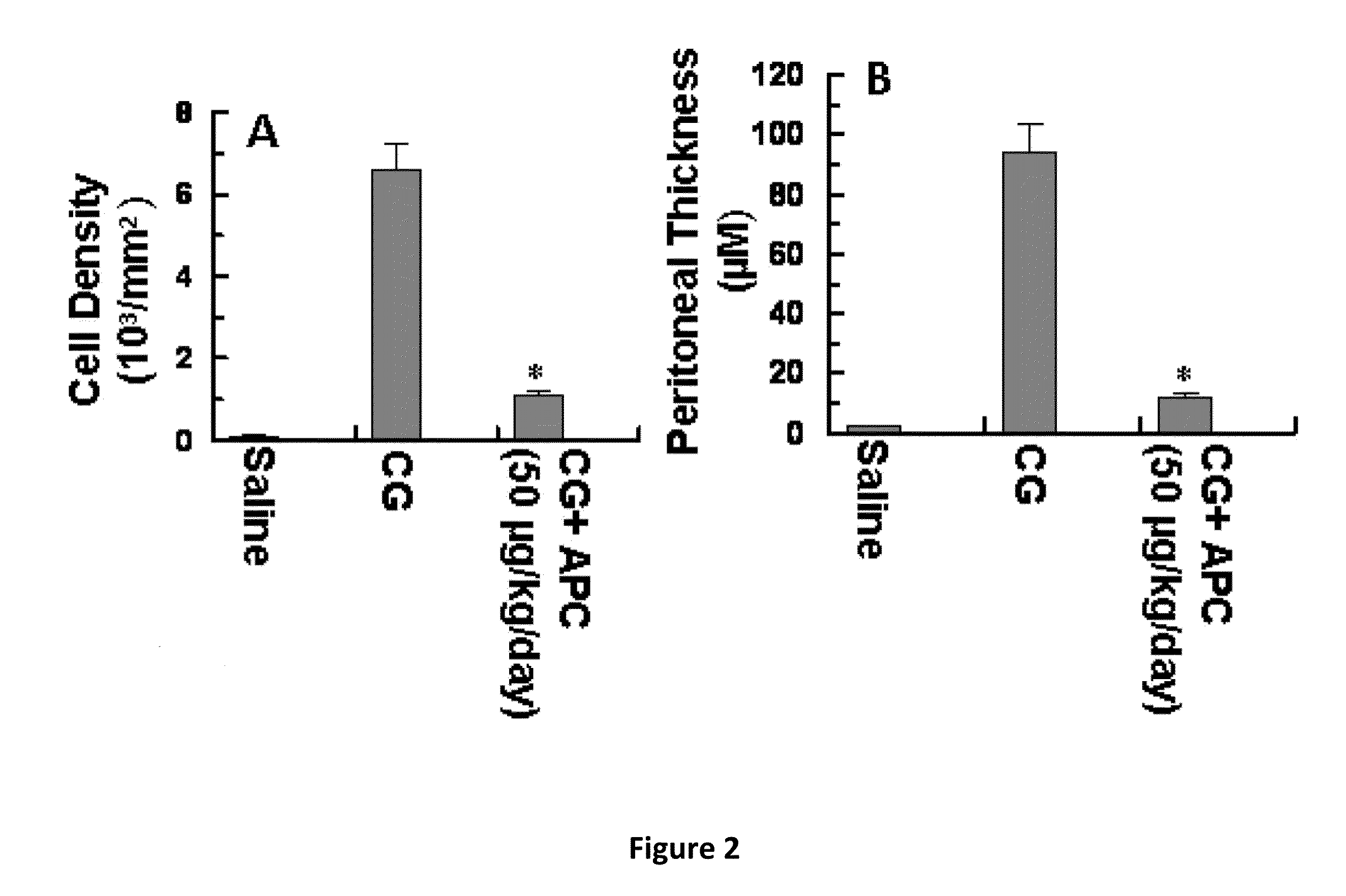Methods for reducing fibrosis induced by peritoneal dialysis
a peritoneal dialysis and fibrosis technology, applied in the field of peritoneal dialysis, can solve the problems of 20% of patients undergoing continuous ambulatory treatment, tissue fibrosis and eventually failure of filtration, and the pathogenic mechanism of this disease process has not been elucidated, so as to reduce the incidence of fibrosis
- Summary
- Abstract
- Description
- Claims
- Application Information
AI Technical Summary
Benefits of technology
Problems solved by technology
Method used
Image
Examples
example 1
[0080]The results of hematoxylin-eosin staining presented in FIG. 1 demonstrate that APC (wild type APC) will inhibit peritoneal fibrosis. Mice injected with only CG exhibit a dramatic increase in the thickening of the peritoneum by day 21 (FIG. 2, microphotographs A and B). By contrast, in the APC-treated group, the CG-induced thickening of the peritoneum was completely inhibited by day 21 (FIG. 1 microphotographs B, C). Quantitative analysis of cell density and peritoneum thickening, (FIG. 2, bar graphs A, B) further illustrate that APC is a potent inhibitor of CG-induced peritoneal fibrosis. Studies using Masson's trichrome staining indicated that the thickened peritoneum present in the CG-control (CG only) group contains a significant amount of collagen (FIG. 3B) by day 21. In the CG-APC treatment group, APC (wild type) completely inhibited the expression of the collagen by peritoneal cells (FIG. 3C) during the same time period (21 days).
example 2
[0081]It is known that enhanced expression of tumor growth factor beta (TGF-β) plays an important role in causing excessive collagen synthesis in the extracellular matrix and tissue fibrosis, thereby leading to formation of a pathological fibrosis in tissues lining the peritoneal cavity. In support of APC inhibiting CG or dialysis-induced peritoneal fibrosis through the inhibition of TGF-β signaling pathway, it was demonstrated that APC (wild type) inhibited the expression of TGF-β mRNA in CG-treated mice (FIG. 4A). Interestingly, further studies revealed that APC also inhibits the mRNA expression levels of cytokeratins (FIG. 4B), integrin2 (FIG. 4C), matrix metalloproteinase 2 (MMP-2) (FIG. 4D) and MMP-9 (FIG. 4E) in the CG-treated mice. Consistent with the anti-inflammatory role of APC through down-regulation of the metalloproteinase proteolytic pathway in this model, APC (wild type) markedly enhanced the mRNA expression level of tissue inhibitor of metalloproteinase 2 (TIMP2) (FI...
example 3
[0083]The Inventors believed that an APC polypeptide with cytoprotective activity but lacking anti-coagulant activity would reduce the incidence of peritoneal fibrosis. In support of this hypothesis the Inventors tested a variant of APC, which possessed these properties. The variant, designated APC-2Cys was tested under the same conditions described for wild type APC. Similar to the results obtained for wild type APC in Example 1, hematoxylin-eosin staining revealed that mice, injected with only CG, exhibited a dramatic increase in the thickening of the peritoneum by day 21 (FIG. 6, panel A), whereas, in the APC-2Cys treated group, CG-induced thickening of the peritoneum was dramatically inhibited by day 21 (FIG. 6 panel A). Quantitative analysis of these results further illustrates that APC-2Cys is a potent inhibitor of peritoneal fibrosis (FIG. 6 panels B and C).
PUM
| Property | Measurement | Unit |
|---|---|---|
| time | aaaaa | aaaaa |
| time | aaaaa | aaaaa |
| time | aaaaa | aaaaa |
Abstract
Description
Claims
Application Information
 Login to View More
Login to View More - R&D
- Intellectual Property
- Life Sciences
- Materials
- Tech Scout
- Unparalleled Data Quality
- Higher Quality Content
- 60% Fewer Hallucinations
Browse by: Latest US Patents, China's latest patents, Technical Efficacy Thesaurus, Application Domain, Technology Topic, Popular Technical Reports.
© 2025 PatSnap. All rights reserved.Legal|Privacy policy|Modern Slavery Act Transparency Statement|Sitemap|About US| Contact US: help@patsnap.com



